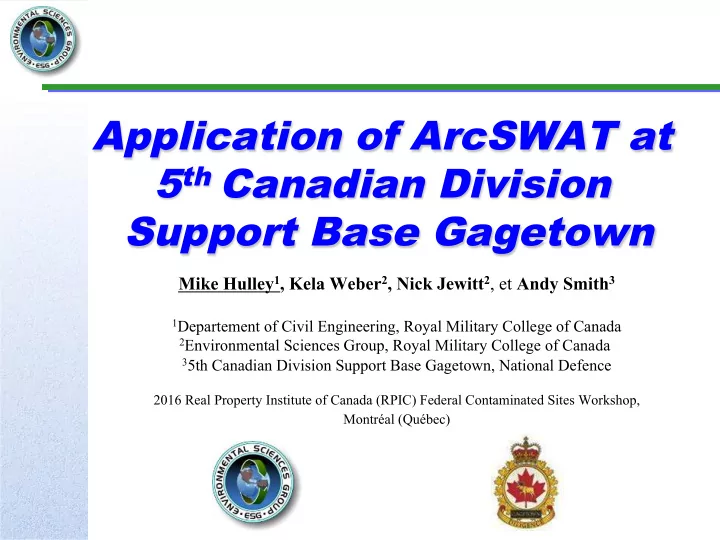

Application of ArcSWAT at 5 th Canadian Division Support Base Gagetown Mike Hulley 1 , Kela Weber 2 , Nick Jewitt 2 , et Andy Smith 3 1 Departement of Civil Engineering, Royal Military College of Canada 2 Environmental Sciences Group, Royal Military College of Canada 3 5th Canadian Division Support Base Gagetown, National Defence 2016 Real Property Institute of Canada (RPIC) Federal Contaminated Sites Workshop, Montréal (Québec)
Gagetown Training Area Study Area
Background • Located in south central N.B and established in 1950’s • Home to the Army’s Combat Training Centre • 21,000 ha of manoeuvre areas and 30,000 ha of impact areas, 830 km of roads, 360 km of tracks, ~500 fords, ~1,200 in-stream culverts and bridges. • 3,300 km of watercourses, ~160 lakes or ponds, ~6,500 ha of wetland. Atlantic salmon and brook trout are key species.
Impacts
Current Control Efforts • 5 year, $50 million Sedimentation and Erosion Control Program (SECP) focusing on the improvement and decommissioning of roads, tracks, fords, other water crossings and re-vegetation of barren soils. Associated works includes stream restoration and wetland creation.
Model goals • Model flow and suspended sediments in the Nerepis River. • Assess the effectiveness of Sedimentation and Erosion Control Program and target restoration. Carried out in conjunction with a benthic monitoring program for Gagetown
Overview • ArcSWAT model development • Hydrologic flow and water quality calibration and validation for the Nerepis River. • Assessment of current mitigation strategies. • Preliminary development and assessment of alternative strategies.
ArcSWAT Model • Based on S oil W ater A ssessment T ool. • Basin ‐ scale, continuous model, is designed to predict the impact of management on water, sediment, and agricultural chemical yields in ungauged watersheds. • Comprehensive surface, subsurface, and in-stream modelling routines included, • Public domain, well supported and documented, and fully integrated into ArcGIS.
Key Model Inputs • Soil, land cover, and topography. • Characteristics of Nerepis River and associated tributaries • Meteorological information. • Flow and water quality monitoring to support calibration and validation. • Sub-basin delineation.
Major Subbasins 0 3.25 6.5 13 Kilometers Kerr Wet weather monitoring KB Brook KB Continuous flow and wet River QB weather monitoring George RG Sucker NR1 Brook Queens SB Brook QB Mountain Brook NR2
Previous Kerr Brook Model
Land Cover Map
Soil Classes Map Gagetown Soil Classes Classes ZZ CanterburyShalyLoam CarletonSiltyClay DeedGravellyLoam GagetownGravellySandyLoam IntervaleSandyLoam KingsLoam LomondGravellyLoam LornevilleSiltyClayLoam MidlandGravellySandyLoam OromoctoSandyLoam ParleevilleGravellySandyLoam Peat QueensLoam RiverbankSandyLoam SunburyGravellySandyLoam TracyLoam WaasisClay 0 3.25 6.5 13 Kilometers Basin
General Approach
Sensitivity Analysis • Vary typical sensitive parameters to determine effect • Determine sensitive parameters through p-value based on Student’s t-distribution • Calibrate sensitive parameters within acceptable ranges • Leave non-sensitive parameters as typical values
Sensitive Parameters Priority ¡ Description ¡ 1 Snow melt base temperature ¡ 2 Initial SCS runoff curve number for moisture condition II ¡ 3 Groundwater evaporation coefficient ¡ 4 Threshold groundwater depth for baseflow ¡ 5 Snow pack temperature lag factor ¡ 6 Saturated hydraulic conductivity ¡ 8 Plant ET coefficient ¡ 9 Surface runoff lag coefficient ¡ 10 Maximum canopy storage ¡ 11 Depth of soil layer ¡ 1 USLE “ C ” (Cover Factor) ¡ 2 USLE “ K ” (Soil Erodibility Factor) ¡
Hydraulic Calibration Nash-Sutcliffe = 0.65
Hydraulic Validation I Nash-Sutcliffe = 0.68
Hydraulic Validation II
Hydraulic Validation (daily)
Hydraulic Validation (daily)
Water Quality
TSS vs Turbidity
Water Quality Calibration Monitoring ¡Results ArcSWAT AverageQ ¡ Max ¡TSS ¡ Max ¡TSS ¡ Year TS ¡(Tons) TS ¡(Tons) (m 3 /s) (mg/L) (mg/L) 2009 184 11791 209 11798 12.2 2010 410 10634 281 13262 11.4 2011 205 9736 232 9684 10.6 2012 300 12787 219 8665 8.2 • Large variability in monitoring results for synoptic TSS and Turbidity. • Preliminary regression relation developed based on Nerepis River event monitoring results. • USLE soil and land cover coefficients adjusted in order to achieve a reasonable agreement.
Water Quality Calibration TSS ¡Observed ¡ TSS ¡Predicted ¡ Event ¡Date (24-‑hour ¡ ArcSWAT ¡ average ¡mg/L) (mg/L) • Reasonable 25-‑Oct-‑09 51 56 agreement on an 29-‑Sep-‑09 80 111 event basis. 15-‑Nov-‑09 63 70 22-‑Jul-‑10 247 232 • Considerable 15-‑Oct-‑10 64 94 uncertainty 5-‑Nov-‑10 133 76 remains. 28-‑Aug-‑11 140 113 20-‑Oct-‑11 46 48 11-‑Nov-‑11 85 60 5-‑Sep-‑12 120 120 31-‑Oct-‑12 191 69
Preliminary Mitigation Assessment • Two illustrative scenarios assessed: 1. 25% of Barren land cover replaced with range land. 2. 100% of Barren land cover replaced with range land. Annual ¡Average ¡Total ¡Solids ¡Loading ¡ (Tons) ¡12-‑year ¡continuous ¡simulation ¡ Loading ¡ Reduction ¡ Scenario (Tons) (%) Baseline 5700 0% 25% ¡Control 5100 11% 100% ¡Control 3480 64%
Preliminary Mitigation Assessment
Next Steps • Growing database of monitoring results addressing the relationship between TSS and turbidity, however, more required. • Assessment of seasonal and spatial variability in TSS and turbidity relationships. • Site specific mitigation strategies need to be developed and critically assessed. • Need to differentiate between stream bedload and overland erosion and sediment transport. • Continue to refine and improve ArcSWAT assessment tool.
Conclusions • Preliminary model calibration and validation completed for flow. • Preliminary calibration for TSS achieved, for individual events and monthly loads, however, additional work remains (seasonal and spatial variability). • Long term model run demonstrates that recent mitigation measures have not significantly changed average flow conditions. • Preliminary assessment of broad land-cover changes demonstrate that significant reductions in suspended solids loadings are achievable with targeted land cover improvements.
Acknowledgements • 5th Canadian Division Support Base Gagetown (project sponsor) • Royal Military College of Canada- Environmental sciences Group (scientific and administrative support) • Environment and Climate Change Canada(Flow and water quality data) • Fisheries and Oceans Canada (Flow and water quality data)
Recommend
More recommend